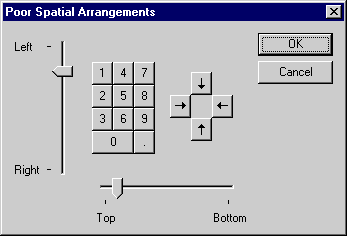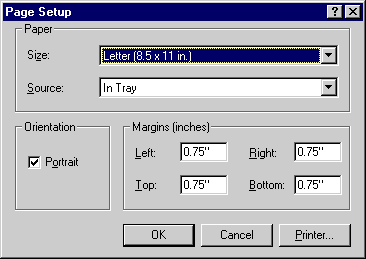Natural Mapping
A natural mapping creates a clear relationship between what the user wants to do and the mechanism for doing it. It creates an obvious and predictable relationship between actions and their effects. Good mappings work without descriptive labels. In fact, the need for a descriptive label is an indication that a mapping isn't natural.
TIP
The need for a label indicates that a mapping isn't natural.
So, how can a mapping be natural? A natural mapping must correspond to the user's preexisting knowledge of the real world. Such real-world knowledge could be from the following sources:
- Physical The mapping corresponds to the laws of physics. Alternatively, a control has a physical resemblance to a real-world and familiar object. For example, a car seat control has a natural physical mapping if its shape models the car seat.
- Spatial The mapping corresponds to our perception of space. The spatial mapping might apply to a single control or to the relationship between several controls. For example, we perceive up to mean on, more, or forward, whereas we perceive down to mean off, less, or backward. For a natural mapping, an up arrow must be above a down arrow and a left arrow must be to the left of a right arrow. Any other relationship would be unnatural, as shown here:
- Cultural The mapping corresponds to cultural customs. For example, the symbol for a male is usually shown wearing pants, and the symbol for a female is usually shown wearing a dress. This distinction is cultural and is understood even though the symbol isn't always accurate. (What I mean, of course, is that females often wear pants as well.)
- Biological The mapping corresponds to biological attributes or distinctions, especially the attributes of human anatomy. The shape of a mouse and the layout of its buttons correspond to the shape of an adult's right hand. The left button is often larger than the right button because of the anatomical preference to point with the index finger.
- Standard The mapping corresponds to well-known standards. For example, the QWERTY keyboard is a natural mapping simply because it is standard, whereas other keyboard layouts do not have what would be considered a natural mapping.

Natural Mapping Attributes
A natural mapping tends to have several of the following attributes.
A one-to-one correspondence between action and result
A single control performs a single function, so controls are not overloaded to perform multiple functions. A good example of an overloaded control is the Add/Remove button from the Add/Remove Programs Control Panel applet discussed earlier.
No translation required
No translation is required, so the user doesn't have to know anything to use a function. This is often accomplished by selecting the appropriate type of control. For example, you should use check boxes to turn options on and off and radio buttons to change modes. You could use a check box to change modes, but doing so would require the user to translate the off state into the opposite mode of the label. In the following dialog box, the user would have to know that the opposite of portrait mode is landscape mode.

For another example, note that Shift+A doesn't require translation, since it is obviously a capital A, and Ctrl+Alt+A needs translation because its meaning isn't obvious.
Speaking the user's language
Closely related to the concept of not requiring translation is that of speaking the user's language. This could mean the user's spoken language, such as English, or any other type of expression understood by the user, such as numeric formats, currency formats, dates, times, and such. This attribute applies to other forms of perception as well, such as color. Note that color selection is always performed in terms of hue, saturation, and luminosity because that's how the eye perceives color. It's easy to understand what changing the saturation of a color does, whereas changing a specific RGB value is much harder to understand since its perceived effect on the color depends upon the other values. For example, adding more red to a shade of red makes the color more brilliant, but adding more red to a shade of cyan makes it less brilliant.
An appropriate metaphor
Metaphors are often used to map between a user interface and the user's knowledge of the real world. Although an appropriate metaphor isn't required for natural mapping, an inappropriate metaphor destroys a natural mapping because it causes the user to draw an incorrect conclusion about what will happen. I'll give an example of this problem in the next section.
Consistency
Consistent behavior reinforces a mapping; having a control or interaction do different things in different circumstances weakens a mapping. Using different terminology for the same task or feature also weakens a mapping. For example, how many clicks does it take to launch a program in Windows? It depends, since it takes a single click to launch a program from the Start menu but a double click to launch from the desktop. Consistency makes a mapping easier to understand and remember.
When to Use Unnatural Mapping
Sometimes a natural mapping simply isn't practical or possible. After all, there's a limit to the number of controls you can use. A good example is the keyboard: every key can be overloaded by using the Shift, Ctrl, or Alt keys. If you have to overload a control, try to do so in a way that doesn't seem arbitrary.
EAN: 2147483647
Pages: 334